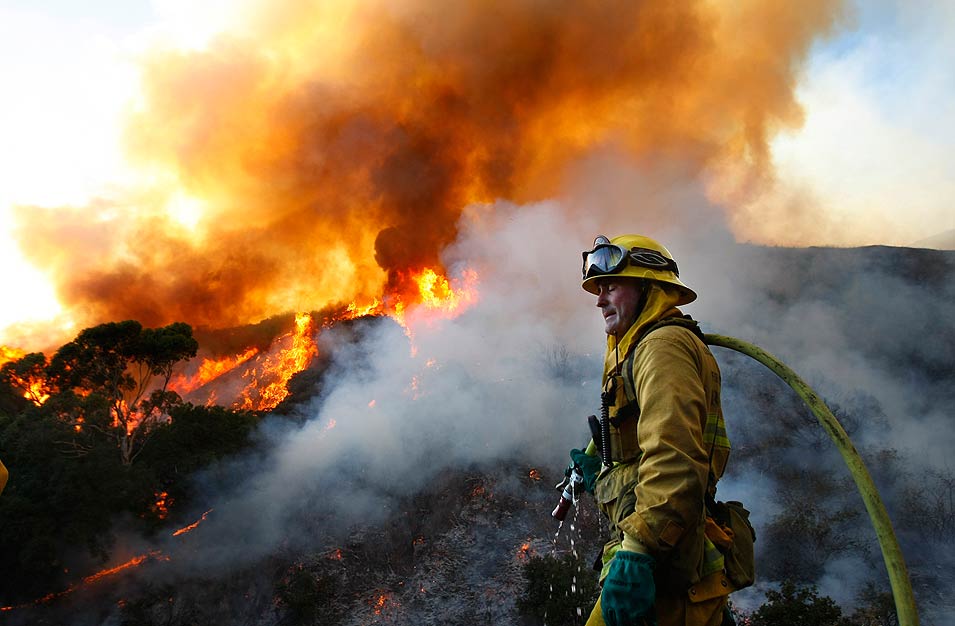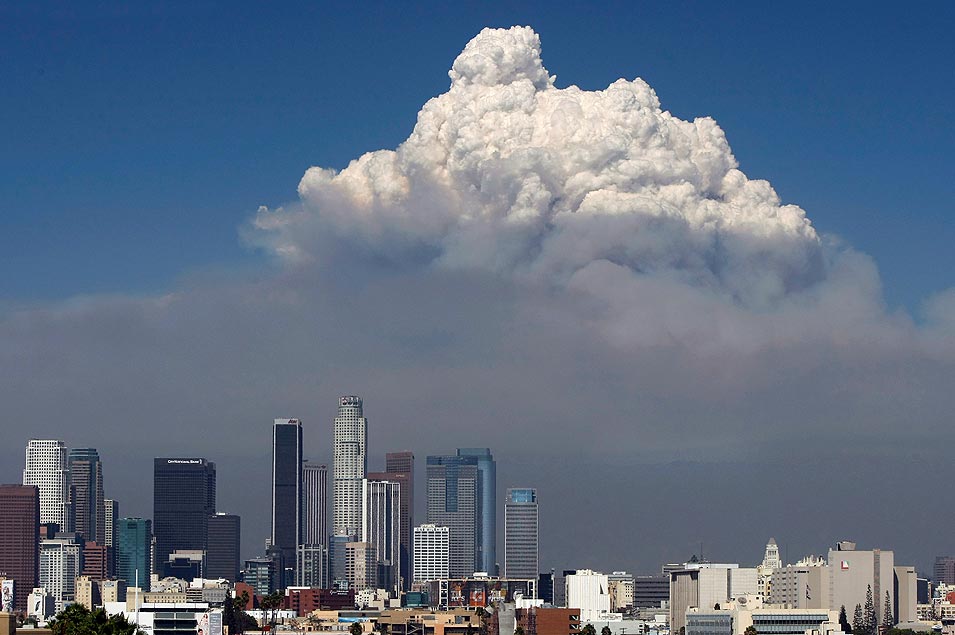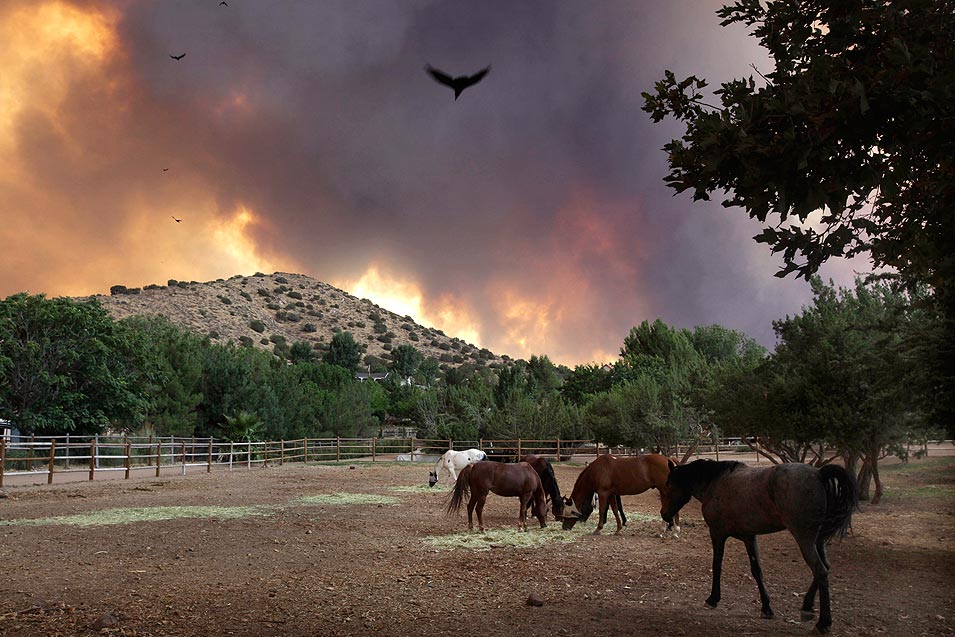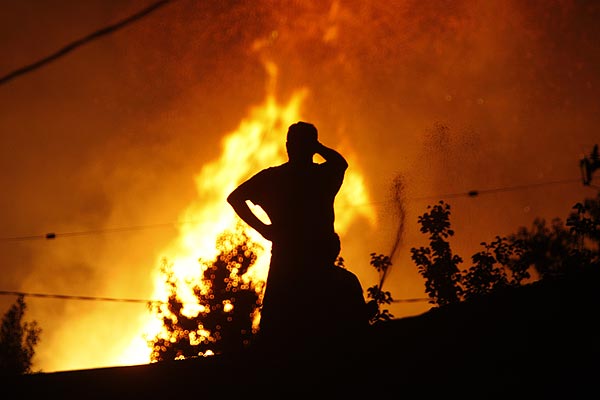
The massive blaze, which has burned more than 50 structures, killed two firefighters and caused thousands of evacuations, grew by about 15,000 acres over the last 12 hours. That's a smaller rate of growth than Sunday or Monday, but officials are still on guard.
[Updated at 7:20 a.m.: At a briefing this morning, officials said they were growing more optimistic about the fire. They said firefighters were set backfires overnight in areas of Glendale, Tujunga and the Santa Clara ridge. More moisture in the air was slowing the blaze. Although temperatures are cooling, officials said they worried about the possibility of gusty winds and dry lightning. No new structures were burned overnight. The fire is 5% contained, but officials expect that number to grow significantly today.]
The fire this morning was bearing down on neighborhoods in Tujunga, where homes have been evacuated.

In the once-threatened area of Briggs Terrace, firefighters using flares set backfires from the top of the ridge gradually down toward the homes. The burnouts neutralized the danger of the wildfire coming down, said Nathan Judy of the U.S. Forest Service.
"Everybody in that neighborhood has nothing to worry about," he said."There's no fuel to burn. We took it away."
Firefighters cut a break between the homes and the burnout nearest them, but the winds were blowing upslope during the operation anyway, Judy said.
The Station fire, the largest of several in the state, was plowing through dense hillside vegetation along the San Gabriel Mountains, cutting a remarkable swath that extends from Altadena into the high desert.
Despite the fire's sprawling dimensions, stretching up to 25 miles from east to west and 18 miles from north to south, aggressive ground and aerial assaults managed to confine the blaze to largely undeveloped areas.

"There have been hundreds of homes saved in this effort," said Los Angeles County Deputy Fire Chief Mike Bryant.
But the outlook for the coming days remains "treacherous," said Mike Dietrich, incident commander for the U.S. Forest Service. "This is a very angry fire. Until we get a change in the weather conditions, I am not overly optimistic. The fire is headed just about anywhere it wants."
Dangerous conditions were expected to increase the risk the blaze could reach new communities in the Antelope, Santa Clarita and San Gabriel valleys. More than 6,000 homes were under mandatory evacuation orders, and full control of the blaze was not expected until well after Labor Day, even as the number of firefighters on the lines swelled to more than 3,700.

Weary fire crews trading 12-hour shifts had little time Monday to mourn the deaths of two L.A. County firefighters killed Sunday when their truck overturned on a mountain road.
Capt. Tedmund Hall, 47, and firefighter specialist Arnaldo Quinones, 34, were part of a team of 65 firefighters -- mostly jail inmates -- trying to defend a camp when flames made a sudden run at their positions, said County Fire Chief P. Michael Freeman. An investigation is continuing, but preliminary indications are that Hall and Quinones were trying to reposition a fire truck, which then tumbled 800 feet down a steep slope. Other firefighters suffered minor injuries in a rescue effort, Freeman said.
At Mt. Wilson, the intensity and unpredictability of the blaze, which continued shifting directions, forced fire crews to pull back from the mountaintop. With the blaze burning on both sides of the only access road to the complex, firefighters could become trapped if the inferno suddenly raced up the canyon walls.
The drama of families having to flee their homes -- or risking all to try to defend their property -- played out repeatedly as searing heat and a generation of accumulated hillside growth fed the fires.
There was confusion and concern when six people refused to evacuate from Gold Canyon near Little Tujunga, officials said. Conflicting reports through the day said the group wanted to stay, or be rescued, after firefighters lighted backfires to battle the blaze in the area. Sheriff's deputies returned to the area three times, officials said, but it appeared the group was not leaving.
As billows of white and black smoke danced ominously close in the Sunland-Tujunga area, Chuck Horn ushered his family and his two prized classic automobiles away from his home.
"We took pictures, tax returns, insurance forms, the dog, the chicken, and that's it," Horn, 61, a retired L.A. County public works employee, said as he prepared to drive away in his baby blue 1931 Plymouth coupe. Next, he planned to move a black 1911 Buick Model 33.



Reader Comments
to our Newsletter